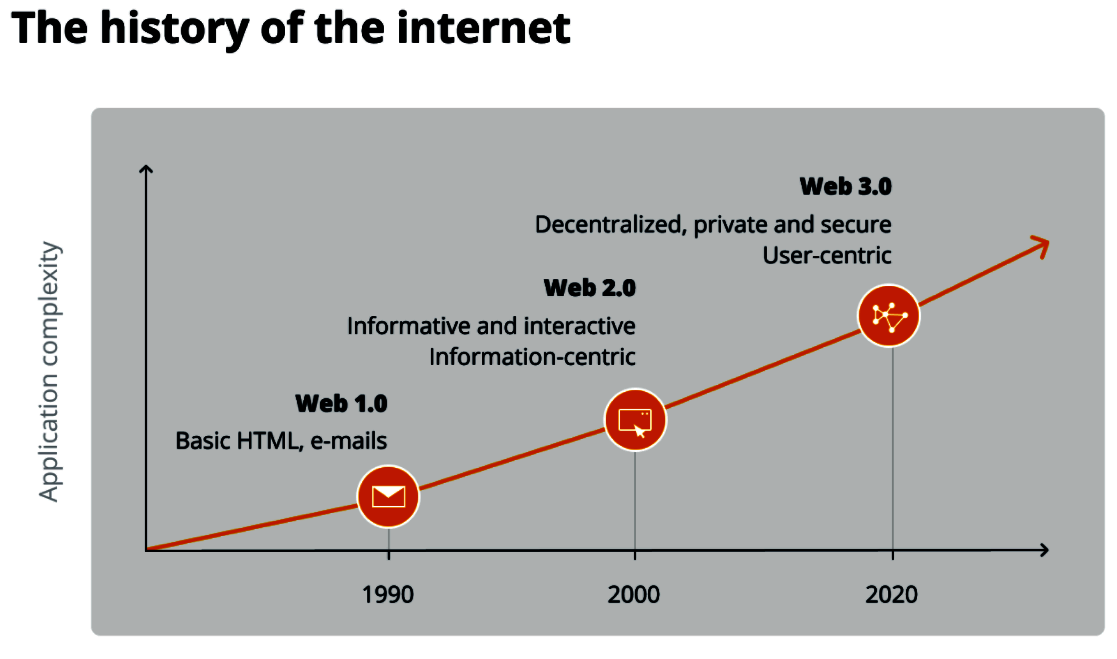Web 3.0 | 18 Jan 2022
For Prelims: Web 1.0, Web 2.0, Web.3.0, Internet, Blockchain Technology.
For Mains: Different Versions of Web, Blockchain Technology, Decentralized Technology and its Significance, Data Security, E-commerce.
Why in News
The concept of Web3, also called Web 3.0, used to describe a potential next phase of the internet, created quite a buzz in 2021.
Key Points
- About:
- World Wide Web, which is also known as a Web, is a collection of websites or web pages stored in web servers and connected to local computers through the internet.
- These websites contain text pages, digital images, audios, videos, etc. Users can access the content of these sites from any part of the world over the internet using their devices such as computers, laptops, cell phones, etc.
- Web 3.0 is a decentralized internet to be run on blockchain technology, which would be different from the versions in use, Web 1.0 and Web 2.0.
- In Web3, users will have ownership stakes in platforms and applications unlike now where tech giants control the platforms.
- Gavin Wood, founder of Ethereum, a block chain technology company, used the term Web3 first in 2014 and in the past few years many others have added to the idea of Web3.
- Previous Versions:
- Web 1.0:
- Web 1.0 is the world wide web or the internet that was invented in 1989. It became popular from 1993. It lasted until 1999.
- The internet in the Web 1.0 days was mostly static web pages where users would go to a website and then read and interact with the static information.
- Even though there were e-commerce websites in the initial days it was still a closed environment and the users themselves could not create any content or post reviews on the internet.
- Web 2.0:
- Web 2.0 started in some form in the late 1990s itself though 2004 was when most of its features were fully available. It is still the age of Web 2.0 now.
- The differentiating characteristic of Web 2.0 compared to Web 1.0 is that users can create content.
- They can interact and contribute in the form of comments, registering likes, sharing and uploading their photos or videos and perform other such activities.
- Primarily, a social media kind of interaction is the differentiating trait of Web 2.0.
- Web 1.0:
- Need of Web 3.0:
- In Web 2.0, most of the data in the internet and the internet traffic are owned or handled by very few companies ex. Google.
- This has created issues related to data privacy, data security and abuse of such data.
- There is a sense of disappointment that the original purpose of the internet has been distorted.
- Significance of Web 3.0:
- Decentralized and Fair Internet: Web3 will deliver a decentralized and fair internet where users control their own data.
- Eliminates Intermediaries: With block chain, the time and place of the transaction are recorded permanently.
- Thus, Web3 enables peer to peer (seller to buyer) transactions by eliminating the role of the intermediary. This concept can be extended to
- Decentralization and Transparency: The spirit of Web3 is Decentralized Autonomous Organization (DAO).
- DAO is all about the business rules and governing rules in any transaction are transparently available for anyone to see and software will be written conforming to these rules.
- With DAO, there is no need for a central authority to authenticate or validate.
Way Forward
- Web3 is in its very initial days and there is no consensus if it will take off like Web 1.0 or Web 2.0 did. There is much skepticism from top tech brains in the industry and the academic community that Web3 does not solve the problems it purports to solve.
- Web3 will require deviation from the current architecture where there is a front-end, middle layer and back-end.
- Web3’s architecture will need backend solutions for handling block chain, persisting and indexing data in block chain, peer to peer communications and so forth.
- Similarly, the middle layer, also called the business rules layer, will need to include handling block chain-based backend.

